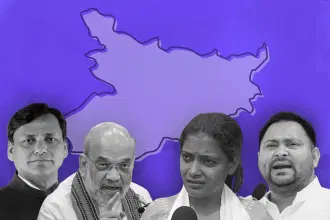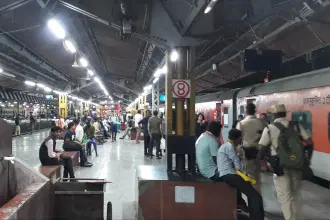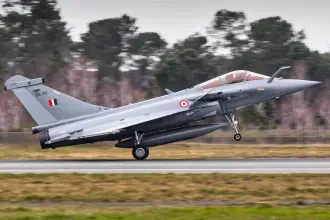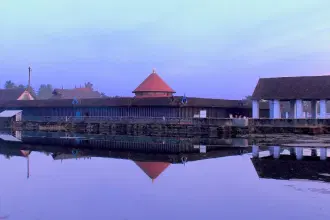Business
Crisis In Bangladesh Is Temporary, Real Opportunity For Coimbatore And Tirupur Textile Industries Is ‘China Plus One’
S Rajesh
Aug 12, 2024, 03:10 PM | Updated Aug 19, 2024, 03:12 PM IST
Save & read from anywhere!
Bookmark stories for easy access on any device or the Swarajya app.
.webp?w=610&q=75&compress=true&format=auto)
.webp?w=310&q=75&compress=true&format=auto)
Tamil Nadu Bharatiya Janata Party (BJP) president K Annamalai recently questioned Chief Minister M K Stalin and the Dravida Munnetra Kazhagam (DMK) government if they are taking any steps towards bringing garment export orders to industries in Tirupur and Coimbatore in the wake of the crisis in Bangladesh.
The prospect is being widely discussed as Bangladesh is a major supplier of garments to the world. Estimates have stated that India could get $300-400 million of export orders per month if customers decide to procure from India.
However, there are questions as to how long this situation would last, if the orders would really come, and whether Tirupur and Coimbatore can handle such demand at short notice given issues like shortages of labour and higher production costs that have plagued the industry over the last year or so.
Customers May Seek To Diversify
Speaking with Swarajya, Prabhu Damodharan, convenor of the Indian Texpreneurs Federation, said that he wished for the situation in Bangladesh to return to normal soon and that, as per reports received, the new government would make restarting garment manufacturing a top priority.
“A large chunk of the country’s exports are from the textile sector. It is only logical that they would make efforts not to lose market share. If they are able to ensure the return of stability and usual production in the next week or 10 days, no big changes are likely to happen in the trade.
“But these kinds of cases create a psychological impact on the buyers with regards to delivery times. In the apparel value chain, whether it is a manufacturer or a retailer, the delivery time is very, very crucial.
“And that fear may lead to 10 to 15 per cent of the orders being diverted to other destinations as a de-risking strategy for one season. It is not going to be a long-term game changer for us,” he said.
Giving an example, Damodharan said that if a European company is placing an order for 1 lakh pieces from a Bangladeshi factory, it is likely that it would place orders for 10,000 to 15,000 with factories in other countries, such as India, in order to ensure timely supply, with the remaining 85,000 to 90,000 going to Bangladesh.
Asked whether industries in Coimbatore and Tirupur could handle more orders, he said that there is 15-20 per cent excess capacity, and thus the expected increase in demand can be catered to without difficulty.
"The issue of a shortage of labour and an increase in production costs is a structural problem that has to be resolved through measures such as better facilities for migrant labour, government support, and improvements in productivity," Damodharan said.
An Indian Trade Service officer who spoke with this writer said he doesn't see any major change happening unless the instability continues for a few months.
"No long-term customer is going to leave a country over a disruption of a couple of weeks.”
He said further, “If the instability continues for too long, even the local manufacturers will move out of the country and set up their plants elsewhere, like in India or in Africa. Ethiopia is one such option. It also has Least Developed Country (LDC) status and enjoys duty-free access, which have been the main reasons for the garment industry to flourish in Bangladesh."
For Long Term, Tap Into ‘China Plus One’
According to Damodharan, the real opportunity for industries in Coimbatore and Tirupur is in the ‘China plus one’ trend that has been playing out since the coronavirus pandemic.
“Our monthly run rate of garment exports is 1.3 billion to 1.4 billion dollars as a country. Bangladesh is at 3.6-3.9 billion dollars. China still exports garments worth around 12 billion dollars a month.
“Both Bangladesh and India should survive in apparel exports, and both should capitalise on the opportunities arriving out of 'China plus one'. We believe 'China plus one' is a 10-year story. We believe this theme will play out over the next 10 years because the shifting of supply chains is not easy or immediate.
“So, we need to focus our energy towards attracting more business away from China, and for that, we need scale, competitiveness, and specialisation. We should market ourselves as a more stable destination without any external disturbances,” Damodharan said.
Commenting on the 'China plus one' strategy for the textile industry, the officer said it suits India’s requirements at this moment.
“Textile is labour-intensive and employs a lot of women. Our demographic dividend is going to help us for another 15-20 years. The Chinese don’t mind letting some of this industry go out of their country, as they now want their scarce and ageing labour to be more involved in high-tech stuff like the manufacturing of chips, drones, electric vehicles, etc.”
Normalcy In Bangladesh Important For Indian Industry Too
While a lot of attention has been given to the possibility of Indian industries getting more export orders due to the Bangladesh crisis, what is forgotten is that the neighbouring country is not just a competitor in the garment industry but also an important export destination for cotton, yarn, and fabric made in India.
The value of these exports in FY 2023-24 was 1.7 billion dollars. This means that trouble in Dhaka is not good news for the weaving and spinning sector in Tirupur.
The Trade Service officer also pointed out another important aspect: the presence of Indian textile companies in Bangladesh, both as manufacturers and as customers.
According to a report by Business Standard, 25 per cent of the textile units there are owned by Indians, with Shahi Exports, House of Pearl Fashions, Jay Jay Mills, TCNS, Gokaldas Images, and Ambattur Clothing being some of the well-known names.
Thus, while there is no doubt that some orders that would otherwise have gone to Bangladesh are likely to come the way of Coimbatore-Tirupur, being the textile hubs they are, the longer-term game for them and for India is in positioning themselves as a good alternative to China.
And the good thing is that this is already happening — the central government has announced production-linked incentives (PLI), a technical textiles mission, and the development of mega-integrated textile and apparel (MITRA) parks.
S Rajesh is Staff Writer at Swarajya. He tweets @rajesh_srn.





